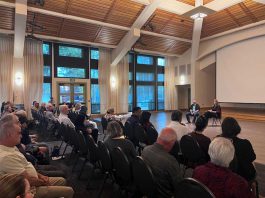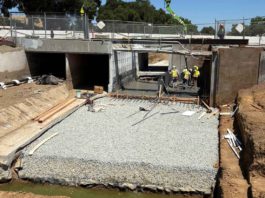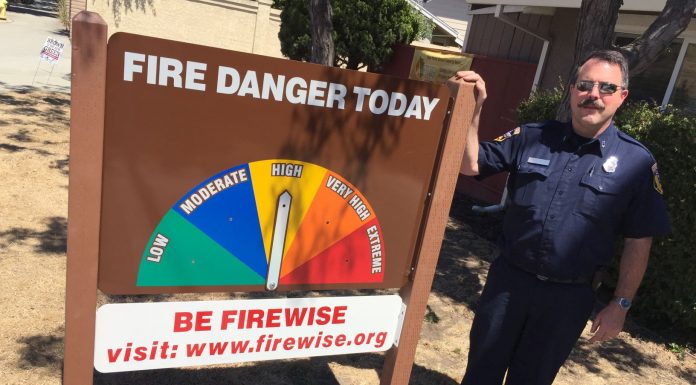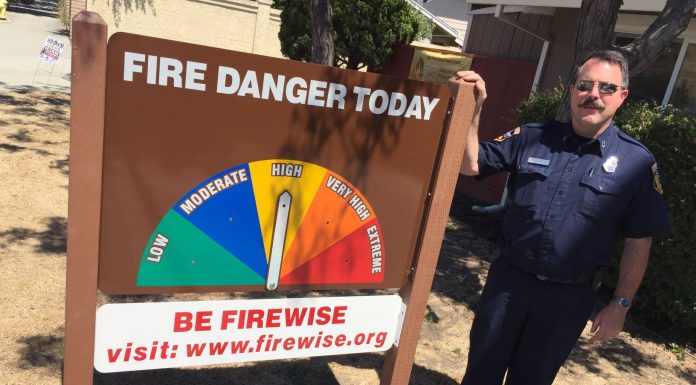Guest view: Teach your children about fire early
This guest view is part of a periodic series of opinion pieces on tips to prepare for wildfire season, which started May 1 in Santa Clara County.As our children enjoy the end of the school year and our open spaces transition into their seasonal amber waves, we encourage you to teach your children about fire safety. Curiosity is a vital part of a healthy childhood and children are naturally curious about fire. Last year, thousands of children “played” with matches. Only, they didn’t learn anything…Fire is the leading cause of death in the home for young children in the U.S. Tragically, one third of the children who died in home fires last year set the fires that killed them. Burns are also a major cause of accidental death for young children in our country, many of whom are burned when playing with matches or lighters.What’s most tragic about these deaths is that almost all of them could have been prevented. Teach your children about fire so that they, and you, don’t get burned.Teaching Your Child About Fire: ‘What is fire?’Fire is a strong natural force, like wind, water or electrical power, which produces heat. Like all energy sources, fire is a tool we use in our everyday lives: cooking food, heating homes, powering cars, and lighting candles are just a few examples of ways we use fire as a tool.Fire can be extremely dangerous, because the heat it produces can quickly get out of control if not handled properly. Because of this danger to people and property, only adults should use fire.Fire is useful, but it is not magic. It is powerful, but it is practical when used wisely. It is a fascinating process, but it’s also a part of everyday life. Fire is not a toy, and young children should never be allowed to use it like one.How do I know that my child is curious about fire?He may ask you questions, or he may stare at the fire, or point to or try to touch matches and lighters, or he may run to the window when fire trucks race by. But why wait for signs? Whenever you use fire, teach your child about it.What if my child has already begun experimenting with fire?Calmly, but firmly, explain that this is not an acceptable way to learn about fire. Explain—but do not overemphasize—the seriousness and danger of playing with fire and immediately begin teaching your child about the safe way to learn about fire. Someone said that if I burn his fingertips he’d learn the dangers…This is simply incorrect. It’s also child abuse. Burning your child will only injure him or her. It will not teach him or her anything positive about fire. It may even give him the dangerous idea to use fire in anger.Fire Marshal Dwight Good serves the Morgan Hill Fire Department and South Santa Clara County Fire Protection District and the CalFire Santa Clara Unit. He has 24 years of fire service experience. He can be contacted at [email protected].
Guest view: Pride month celebrates diversity
Morgan Hill City Councilman Rene Spring delivered the following comments at a June 1 rainbow flag raising ceremony at City Hall Plaza on Peak Avenue. “As I prepared for what I wanted to say at our local ceremony, I googled around and came across an amazingly well written speech by Senior Chief Hospital Corpsman Tom Guest. His words speak for themselves. I found them so fitting for our ceremony. He's one of my heroes!,” Spring said, including portions of Guest’s speech in his comments at the local ceremony. The flag will continue to fly over City Hall throughout June, commemorating the month as LGBTQ Pride Month in Morgan Hill.Good morning. My name is Rene Spring. I am Morgan Hill’s first openly gay councilmember.Thank you all for coming. We are here today to celebrate the beginning of LGBTQ Pride Month, as it’s being celebrated in many communities across our region, throughout the country and even in many countries all over the world.It is great to see so many of you joining this event today and to show your solidarity and respect for the LGBTQ community! I did not expect this great turnout! Homophobia, biphobia and transphobia still exist. Events like today are a signal that we need to change that and need to embrace each other even more.In my short speech today, I will use the generic term “gay” instead of the acronym “LGBTQ.”Partly because it is the word I am most comfortable with, it is the word I feel is most universal and it is the word I am least likely to get tongue tied over.PRIDE. What exactly do we mean by GAY PRIDE? Does that mean we are proud to be gay? Isn’t that sort of like being proud to be short, or proud to have blue eyes? We really have nothing to do with the fact that we are gay.I started to realize I was different at about the age of 12 or 13. By the age of 16 or 17, I was certain I was gay. I was never PROUD of it. I was ashamed; I was embarrassed; I was afraid. I came out to my family and friends at the age of 17, and to my surprise, their response was: “Well, finally, we knew!” I was lucky to be embraced by a loving family and wonderful friends, but I also realize not all are that lucky yet.We are born gay. And if you are gay, you can deny it, you can pretend, you can act. But you cannot change that fact.Gay pride is not about being proud of the fact that we happen to be gay. It’s about NOT allowing others to make us feel shame because we are gay. It’s about NOT allowing others to define our worth based on our sexuality,It’s about NOT allowing others to define the love we share as less pure, less real, less deserving of recognition.Gay pride is about owning who we are. Gay pride is about valuing the diversity that is humanity in all its varied presentations.According to the Flags of the World Project, which unravels the history behind many of the world's flags, the original Pride Rainbow Flag was designed by a San Francisco individual named Gilbert Baker who just recently passed away. The rainbow flag is also symbolic because of its diversity.As you know, Morgan Hill is a very diverse community, in many ways. I believe that strength and solidarity can be found in diversity. Through this strength and solidarity, we can build communities which are based on the foundations of acceptance and inclusivity. Diversity is not just about recognizing our differences; rather it is about acknowledging our uniqueness and individuality.In acknowledging this uniqueness, it's evident that we're actually very much the same. We are people with different identities and layers—but people nonetheless.Welcome to LGBTQ Pride month in Morgan Hill—the first one ever in Morgan Hill!
Guest view: Water district CIP includes flood control projects
When it comes to big infrastructure projects, the Santa Clara Valley Water District believes it’s important to look at the plans for improvements holistically, and from a long-term perspective. That’s the purpose of the Capital Improvement Plan (CIP), heard May 9 and approved by the Board of Directors.The water district’s 5-year CIP is a rolling plan that describes capital investments planned for the next five fiscal years.The FY 2018-2022 CIP includes 66 projects with proposed funding of $197 million in FY 2018. These projects include 30 water supply projects, from water treatment plant upgrades to seismic retrofitting of dams to pipeline rehabilitation and investments in the Recycled and Purified Water program. They also include 17 flood protection projects along Upper Guadalupe River, Coyote Watershed, San Francisquito Creek, Upper and Lower Llagas Creek and Sunnyvale East/West Channels.Water resources stewardship makes up nine projects from environmental enhancement to mitigation to feasibility studies. There is also money set aside for three building and grounds projects and seven information technology projects. Over the next five years, the planned construction work is estimated to create or sustain 8,000 to 16,000 jobs.The money for the projects included in the CIP comes from a variety of sources, including a special parcel tax, a portion of 1 percent ad valorem property taxes, benefit assessments, groundwater rates, as well as through grants and partnerships with local, state and federal agencies. The CIP is developed in parallel with the fiscal year’s water rates, and to fully fund the water supply projects in the FY 2018-2022 CIP, water rates need to increase by 9.6 percent in North County, which extends to just south of San Jose, and 6.4 percent in South County.Projects included in the CIP are carefully selected to meet the needs of the community and the water district. Projects must meet three criteria: they must conform to the board’s priorities and contribute to the water district’s objectives; have identified funding for the duration of the projects; and be coordinated with the local jurisdiction’s General Plan. The water district solicits community input through the public hearing process. The public hearing opened April 26 and closed May 9.The water district board also weighs in before the draft is assembled to ensure projects fit with the board’s priorities.Once that process is complete, the draft is assembled and made available for review.The public hearing on the CIP concluded at the regular meeting of the water district board of directors. For more information, visitvalleywater.org.Submitted on behalf of the Santa Clara Valley Water District. John Varela represents the district that includes South County on the SCVWD board of directors. He can be contacted at (408) 265-2600 or [email protected].
Guest view: Be ember aware: Store firewood 30 feet away
This guest view is part of a periodic series of upcoming op-eds on tips to prepare for wildfire season, which started May 1 in Santa Clara County.Most people believe that wildfires ignite homes through direct contact with flames, but it is rare to have a home ignite this way. Flaming brands and embers can travel a mile or more ahead of the active front of a wildfire, and up to 60 percent of wildland/urban interface home ignitions result from embers.Your home could be at risk. Make changes now to reduce the ember threat to your home. Clean out debris from under your deck, and move woodpiles away from your house.Our “Ember Aware” campaign is intended to educate people on the risks of ember cast and the actions they can take to reduce those risks, to encourage residents to harden their homes against embers and/or to maintain those ember-resistant features, and to practice ember-safe housekeeping and landscaping. You can learn more at emberaware.comTip #3: Chuck that woodHow much wood could a woodchuck chuck? If he lived in one of California’s high fire hazard areas, he should chuck all of it at least 30 feet from his home.One of the most common ember hazards homeowners create is the placement of firewood stacks next to their home. During a wildfire, hundreds of burning embers could become lodged within the stack. The dry, high winds that often accompany wildfire can fan the embers and cause ignition. Once burning, the firewood stack can jeopardize just about any home, regardless of construction material, because of its ability to ignite combustible siding, provide a flaming exposure to windows and break the glass, or climb to the eave and possibly enter into the attic.Firewood should be stored at least 30 feet from the house, deck and other structures during fire season. If the firewood stack is located uphill, make sure burning logs won’t roll downhill and ignite the home. Don’t place the stack under tree branches or adjacent to wood fences that are connected to the house. Don’t let your firewood stack be the kindling for your house fire.Fire Marshal Dwight Good serves the Morgan Hill Fire Department and South Santa Clara County Fire Protection District and the CalFire Santa Clara Unit. He has 24 years of fire service experience. He can be contacted at [email protected].
Guest view: May is cystic fibrosis awareness month
The California State Senate has recognized May as Cystic Fibrosis Awareness Month with the passage of Senate Resolution 34, which I was proud to have authored. This designation will help bring attention to this life debilitating disease. Cystic fibrosis is the most common fatal genetic disease in the United States, with 30,000 people currently afflicted and 1,000 new cases diagnosed every year. One out of every 3,500 babies born in America has cystic fibrosis, and more than 75 percent of people with the disease are diagnosed before the age of two. Prompt diagnosis of the disease can lead to better treatment of the symptoms and control over the disease, which is defined by a thick buildup of mucus in the lungs, pancreas and other organs, causing persistent infections, lung damage and respiratory failure. And while there is no known cure for this chronic and progressive systemic disease, there have been advancements in research that have produced promising leads in gene, protein and drug therapies that have led to longer life expectancy and better life quality.In the 1950s, cystic fibrosis was almost exclusively found only in children, few of whom lived long enough to even attend elementary school. Through early diagnosis, advancements in medicine and a better understanding of the disease, now over half of those with cystic fibrosis are 18 years of age or older and have a life expectancy into their early 40s.According to the Centers for Disease Control and Prevention, more than 12 million Americans are symptomless carriers of the cystic fibrosis gene, and if both you and your partner have the gene, it greatly increases your child’s chance of having the disease.I applaud the work of the researchers and advocates who work for a cure every day and create innovative ways of treating the disease. Through their efforts, those afflicted with cystic fibrosis can pursue their life goals, whether it is a particular career path, marriage, children or all of the above. Please take a moment to learn more about cystic fibrosis.Sen. Bill Monning represents the 17th State Senate District, which includes all of San Luis Obispo and Santa Cruz counties, and portions of Monterey and Santa Clara counties.
Guest View: Clean your gutters for fire protection
This guest view is the first in a periodic series of upcoming op-eds on tips to prepare for wildfire season, which started May 1 in Santa Clara County.No matter where you live, the most common reason homes burn during a wildfire is because embers land on something easily ignitable around the home. Remove leaves and pine needles from your rain gutters. Make changes now to reduce the ember threat to your home.Flaming brands and embers can travel a mile or more ahead of the active front of a wildfire and up to 60 percent of wildland/urban interface home ignitions result from embers.Most of the activity that makes a home less vulnerable to ignition focuses on the home and its immediate surroundings. Our Ember Aware campaign is intended to educate people on the risks of ember cast and the actions they can take to reduce those risks, to encourage residents to harden their homes against embers and/or to maintain those ember-resistant features, and to practice ember-safe housekeeping and landscaping. You can learn more at emberaware.comTip number two: Unclutter the gutter.Rain gutters attached to the edge of your roof are perfect for catching embers during wildfire. Burning embers can land in the gutters, and if they are filled with dried leaves, pine needles and twigs, a fire can start and possibly ignite the roof, roof sheathing and fascia. Even houses with fire-rated roofs are vulnerable to this type of ember attack. Rain gutters made of vinyl will melt and drop into flower beds, igniting plants next to the house and maybe even combustible siding. To keep your home safe, we suggest that you:• Remove all dried leaves, pine needles or other materials from your rain gutters before fire season.• Keep a ladder handy and check your rain gutters throughout the fire season, cleaning them out as necessary.• If a wildfire is approaching and there is no time to clean out the debris, plug the rain gutter downspout with a tennis ball, or something similar so that the downspout will be plugged, and fill the rain gutter with water.Fire Marshal Dwight Good serves the Morgan Hill Fire Department and South Santa Clara County Fire Protection District and the CalFire Santa Clara Unit. He has 24 years of fire service experience. He can be contacted at [email protected].
Guest view: Let’s all go to the park
The City of Morgan Hill is breaking ground on several downtown community parks while continuing to invest in our existing city parks and trails. Construction is beginning on Little Llagas Creek Trail, located west of the Third Street and Monterey Road intersection; Depot Park, along Depot between Third and Fourth Streets; and “Hill Top” Trail, connecting Third and Fifth Streets at Del Monte Avenue. I am proud to make beautiful parks and trails accessible to our residents and encourage you to use them here and throughout South County.The city invests in parks and trails for their many economic, health, environmental and quality of life benefits. According to the Centers for Disease Control and Prevention, providing places residents can be physically active can improve both physical and mental health. Chronic disease sufferers can greatly benefit from walking on local trails and spending time at our parks. Being outdoors can increase vitamin D levels, decrease blood sugar levels for diabetes and reduce feelings of depression, thereby improving mental health. Parks and trails function as a hub for community members to meet for social events and recreational activities resulting in increased social cohesion strengthening our community.The City of Morgan Hill has partnered with Santa Clara County Public Health, the City of Gilroy, Santa Clara County Parks, the South County Collaborative and the South County United for Health Leadership Team to coordinate a “Let’s All Go to the Park” project to promote parks and trails as a destination for physical activity and meeting other members of the community. Five free events have been planned in South County geared to all fitness levels.I encourage residents to participate in all five of these events. The first event is at 10 a.m. May 13, starting at the east side of the Centennial Recreation Center, 171 W. Edmundson Ave., and will include a walk or bike ride along Little Llagas Creek Trail. Please join Santa Clara County Supervisor Mike Wasserman, Morgan Hill Unified School District Superintendent Steve Betando and me for a walk or bike ride on the Little LLagas Creek Trail.Taking steps toward better health as a community is important. More details are available on the City of Morgan Hill website, morganhill,ca.gov.Steve Tate is the mayor of Morgan Hill. He can be reached at [email protected].
Guest view: Be ember aware for wildfire season
This guest view is the first in a periodic series of upcoming op-eds on tips to prepare for wildfire season, which officially starts May 1 in Santa Clara County.Most people believe that wildfires ignite homes through direct contact with flames, but it is rare to have a home ignite this way. Thanks to effective defensible space campaigns, very few homes are in direct contact with traditional wildland fuel models (e.g., uninterrupted fields of seasonal grass, flammable brush or tree canopies). The collective experience of our wildland firefighters suggests that homes most commonly ignite from airborne flaming brands and embers.Flaming brands and embers can travel a mile or more ahead of the active front of a wildfire. Scientific research finds that up to 60 percent of wildland/urban interface home ignitions result from embers landing on flammable materials such as roofing or landscaping materials, or ember penetration into concealed spaces through vents and other structural openings.Most of the activity that makes a home less vulnerable to ignition focuses on the home and its immediately surroundings. Defensible space preparations are part of the equation, but they do not address the ember threat. Our Ember Aware campaign is intended to educate people on the risks of ember cast and the actions they can take to reduce those risks, to encourage residents to harden their homes against embers and/or to maintain those ember-resistant features, and to practice ember-safe housekeeping and landscaping. You can learn more at emberaware.com.In the coming weeks, we will provide a series of articles and tips on the topic. Make changes now to reduce the ember threat to your home. Tip number one: Stop shaking.• The most reliable way to predict which houses will survive a wildfire and which will be destroyed is by looking at the roof.• Houses with wood shake or shingle roofs are many times more likely to be destroyed during a wildfire. Using wood shakes or shingles for roofs in high fire hazard areas is like stacking hundreds of pounds of kindling on top of your home. During the hot summer months, the shakes or shingles can be nearly bone dry and easily ignited by embers. The embers come from pieces of burning material that can be lofted high into the air during a wildfire and travel a mile or more from the actual fire.• Unfortunately, there is no effective, inexpensive long-term solution to the ember threat to wood roofs. We recommend replacing wood shake or shingle roofs with a rated, fire-resistant roofing material, such as asphalt composition shingles, metal, or concrete or clay tile. Although this can be expensive, it may well be the one thing that saves your home when the embers arrive.Fire Marshal Dwight Good serves the Morgan Hill Fire Department and South Santa Clara County Fire Protection District and the CalFire Santa Clara Unit. He has 24 years of fire service experience. He can be contacted at [email protected].
Guest view: Schools are safe from federal immigration overreach
On Sunday, March 26, residents gathered at St. Catherine Church in Morgan Hill to receive educational information about immigrant rights. Morgan Hill Unified School District Superintendent Steve Betando was asked to speak about the district’s stance on the national immigration discussion and what MHUSD is doing to help students and families. Here is a portion of that speech, which can be read in its entirety on mhusd.org.
Guest View: Celebrate and participate in Earth Day April 22
April 22 marks the 47th Earth Day—a day created to celebrate our planet, environment and wildlife. Every Californian has a story to tell about how nature has made their lives richer. For some, it is regional food, lakes and rivers, or a beloved local park. For others, it is the ties to ranches, working farms, forests or our magnificent public lands. The ecosystem is one of California’s greatest assets. We have a unique and diverse climate and geography, and some of the most extraordinary plants and wildlife in the world.Today, the fight for a clean environment continues with increasing urgency, as the effects of climate change become more and more apparent. Earth Day 2017 provides an opportunity for all of us to do something meaningful for our planet by giving back in our communities. Thousands of volunteers will be needed throughout California to assist with projects such as campfire center improvements, habitat restoration, native garden conservation, fence building, trail maintenance and beach cleanup.The idea for a national day to focus on the environment came to Gaylord Nelson, then a U.S. Senator from Wisconsin, after he took a trip to Santa Barbara following a devastating oil spill off California’s central coast. Upon returning to Washington, D.C., Nelson introduced a bill designating April 22 as a national day to celebrate the Earth. The date was chosen to help commemorate the birth of California naturalist and conservationist John Muir, who was born April 21, 1838.In 1970, the first Earth Day celebrations took place in hundreds of communities across the United States, bringing together millions of Americans who supported environmental reform. By the end of that year, Earth Day had led to the creation of the United States Environmental Protection Agency, and the passage of the Clean Air, Clean Water, and Endangered Species Acts. By 2000, formal events celebrating Earth Day were being observed in 184 countries, and more than 500 million people participated in those events. It now is considered the largest secular observance in the world, celebrated by more than one billion people every year.Earth Day is a day of action designed to change human behavior and provoke science-based policy changes, and serves as a reminder to us that our planet’s future is in jeopardy. The science is clear: climate change continues to harm our planet and has led to rising sea levels, warmer oceans, rising global temperatures and increased incidences of extreme weather events. I encourage everyone to attend local Earth Day events, which are planned throughout the month of April in communities throughout California. Help do your part to restore and care for the places where we live, work and play…for this and future generations. Seize the opportunity to ensure that nature continues to sustain us in the 21st century.Monning represents the 17th Senate District, which includes all of San Luis Obispo and Santa Cruz counties, and portions of Monterey and Santa Clara counties.

















